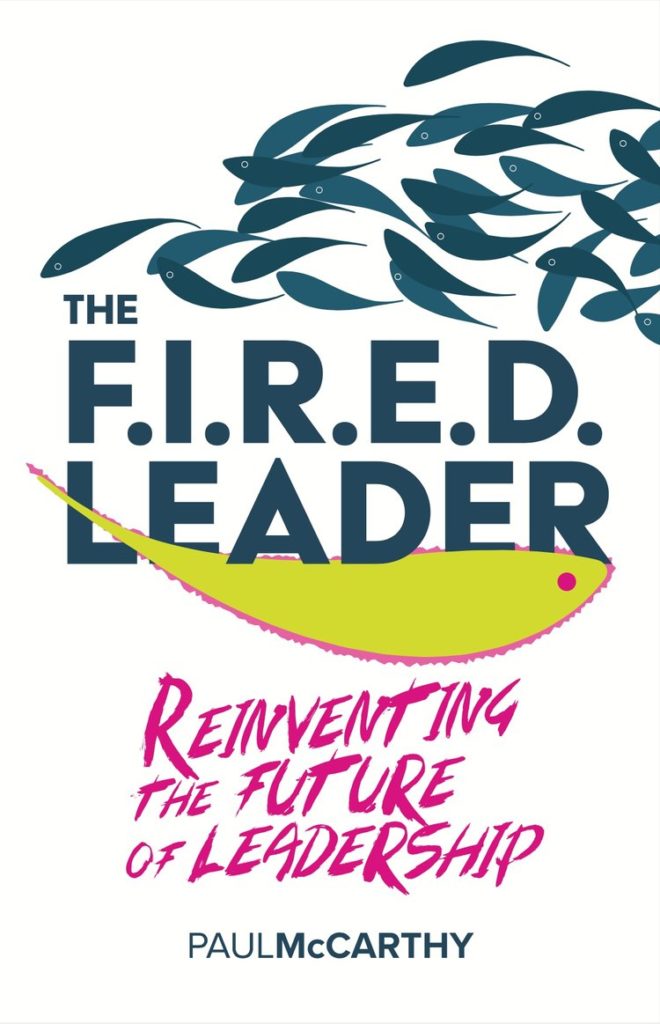
Nobody likes getting fired. But Paul McCarthy was able to transform that experience into something meaningful, ultimately resulting in his new book The F.I.R.E.D Leader: Reinventing the Future of Leadership. Paul is British and is now based in Canada. He has held various executive and consulting positions over the years in Canada and the UK.
I first came into contact with Paul at the end of Dr. Abe Khoureis’ 3rd Global Thought Leaders Symposium in 2022, when I was a panelist. We subsequently had an interesting Zoom call, which got me intrigued about the book and his professional plans.
I’m grateful to Paul for answering my questions about the book, his career, and his perspective on the state of leadership development. The Q&A has been edited for clarity and length.

How would you characterize the basic premise of, and the research that went into writing The F.I.R.E.D Leader: Reinventing the Future of Leadership?
This started with a hypothesis, which asked ‘are we firing the types of leaders with the leadership qualities we will increasingly need to navigate ongoing disruption?’
The catalyst for pursuing this path was my own firings from four senior/exec leadership roles – which got me curious because a key part of my consulting expertise with clients was to develop leadership capacity, capability and competency – which also meant having to focus on current and future trends in how to develop leaders effectively for the future.
My firings led me to question whether our current approaches to developing leaders (it would go further into also asking about the way we identify, recruit, and onboard leaders) were preparing those leaders, future leaders and organizations for the future. I would be hired for having certain leadership qualities and then upon displaying them, I would get fired. This incongruence, disconnect, and apparent hypocrisy intrigued me to further explore. Though to begin with, I didn’t know what to explore.
So I began researching content and overviews of as many leadership development programs as I could over a 6-12 month period and realized that the five leadership qualities I was hired and fired for (which would later become the acronym F.I.R.E.D – Fresh Thinking; Inquisitive Nature, Real & Accountable, Expressive & Challenging and Direct & Transparent) were missing from how leaders seemed to be developed.
This got me even more curious, so I began talking with others in the L&D {learning & development} space, including leadership development specialists and those in the HR, leadership space about what I was seeing – attending a few conferences as part of research and talking with people about this. I researched leadership identification, recruitment, and onboarding practices as part of this. Gathering information, data and anecdotal case studies and stories from the sources mentioned.
As part of working with my support writer in 2019, we also reviewed HR and Leadership journals, articles, research, as well as industry think tanks and reports from organizations including DDI, Brandon Hall Group, Conference Board of Canada and a range of others, which enabled us to extract certain pieces of research and statistics to either reinforce or refute the original hypothesis.
I am a dot connector because I’ve reviewed the research, and see the gaps. I see the disconnect between levels of ineffective leadership development and growing leader level disengagement, turnover, low morale, and low productivity of leaders within organizations. I also began asking if this was in part a broader dysfunctional approach to how we identify, recruit, onboard, and develop leaders.
There are many leadership models/modalities already in existence. Do you expect any pushback from some readers with what we might call ‘model/modality fatigue’ from what they have previously read or experienced, and a reluctance to appreciate a new entry?
I also began to form another hypothesis, which was ‘whether we needed a different kind of leader as part of navigating ongoing disruption – a leader with disruptive leadership capacity, capability, and competency.’
From reviewing the available research and resources on leaders who have disruptive leadership qualities, those types of leaders are misunderstood and not valued for their contributions and role in making organizations successful. Korn Ferry’s recent research, The Self-Disruptive Leader, delves further into why and how we need disruptive leaders. Research from the Global Innovation Index directly correlates a country’s level of ongoing innovation to its ability to identify, cultivate, and embrace leaders with disruptive capacity and capability.
There is a general stigma about leaders who are called ‘disruptive’ because the term is viewed as a negative in general. I have reviewed the research and believe that the future of leadership will reframe how it sees this term and organizations will continue to seek out ways to identify, cultivate, and embrace disruptive leaders and disruptive talent.
From my analysis of research, disruptive leaders are characterized by six qualities, which will increasingly be needed by leadership and organizations to navigate ongoing disruption:
- Transparent – courageous challengers of the status quo
- Purpose Focused – purpose driven, build trust quickly and curiously innovate
- Enhancer – Empathetic, big picture thinkers and improvement focused
- Adaptable – Ability to continually adapt, see opportunities and transform
- Divergent – Divergent in approach, perspectives and values
- Decisive – Embrace uncertainty with decisiveness, agility and resiliency
These qualities are also representative of the F.I.R.E.D. leader, the archetypal disruptive leader.
I also state that this is not just another leadership book – the world does not need another leadership book – it needs honest conversations about the true state of ineffectiveness of the leadership industry.
As part of the above research, I began to ruffle the feathers of some in the leadership development industry, whilst many others agreed that my sentiment was correct – leadership is broken and few are openly talking about this. With $366 billion spent on leadership development each year and rising, a meager 14% of those who ‘procure’ such leadership development think it works.
And no one seemed to be talking about this.
I also reference the notion that it is precisely because there are so many different opposing and contradictory leadership models already in existence that we are in this global situation of having dysfunctional approaches to leadership. My work aims to simplify the way we look at leadership and is not based on convoluted or complex theories of what works vs what doesn’t work that are derived from peer reviewed and academic type experimentation.
This has sometimes brought my work into being challenged by the academics who believe that leadership models must stand the test of repeated lab experimentation before they are deemed to be effective at supporting leaders to be effective.
I don’t agree with this premise – and am also increasingly seeing that the world is waking up to a new kind of leader who isn’t created or validated through an academic lab experiment.
Organizations that will embrace this new approach to the future of leadership will be progressive thinking ones that are open to evolving and new ways of thinking and approaching leadership. People and organizations that continue to cling to outdated models and approaches are not the ones I choose to serve as part of my thought leadership. And they are not the future.
How has your past work experience, recent and otherwise, informed your current work and your writing, and what you plan for the future?
This path was an accidental one for me. As part of every leadership identification, recruitment, and onboarding experience with the organizations I’d been interviewing with, I conveyed my leadership mindset, style, approach, and philosophy. As I began working with each organization, I literally ‘practiced what I preached,’ displayed the leader qualities I had conveyed as part of the interview processes.
My direct experience of being fired for being a F.I.R.E.D. leader has ultimately served as the initial catalyst for my self-reflection, hypothesis generation, and research into this field. I realized that our current approaches for how we identified, recruited, onboarded, and developed leaders wasn’t preparing them for the future.
I began talking with others about my hypothesis, my research findings, and my intentions to bring this out further into the HR and leadership industries to change the future of leadership, one conversation at a time.
Through an intentional period of five years, I have shared my perspectives with the world with the aim of gauging receptivity and appetite to new ways of thinking about the future of leadership. Global appetite is now clearly there and growing.
My plans for the future include taking the concepts explored in my book and thought leadership out to organizations, leaders, and think tanks; and speaking, writing, consulting, and teaching the principles underpinning my work and F.I.R.E.D. leadership. Two further books are planned with the aim of understanding the true prevalence and impact of the F.I.R.E.D. leadership qualities at each leader level and in a range of industry sectors, as well as normalizing the F.I.R.E.D. leadership qualities and the principles of ‘disruptive leadership’ into how future leaders are identified, recruited, onboarded, and developed.
